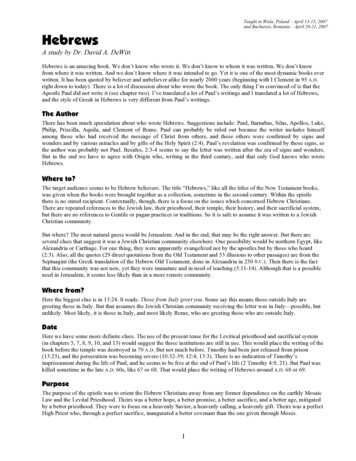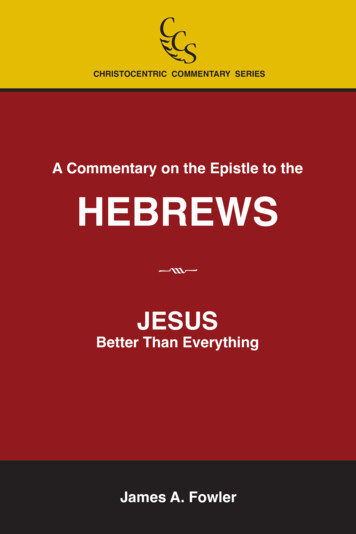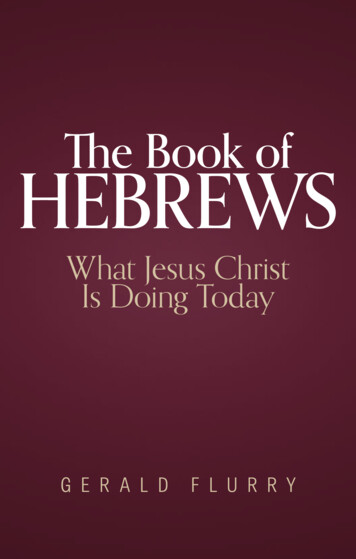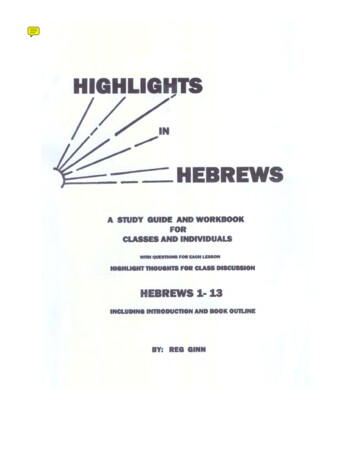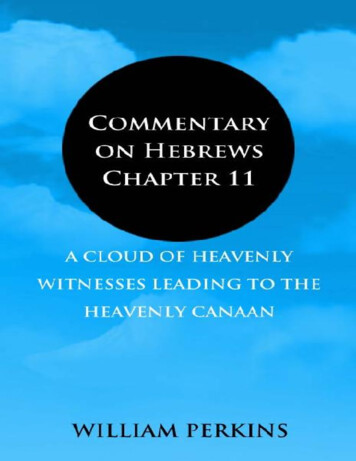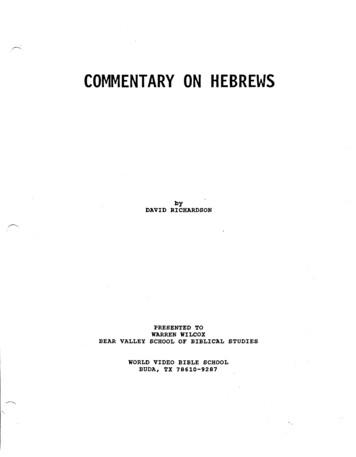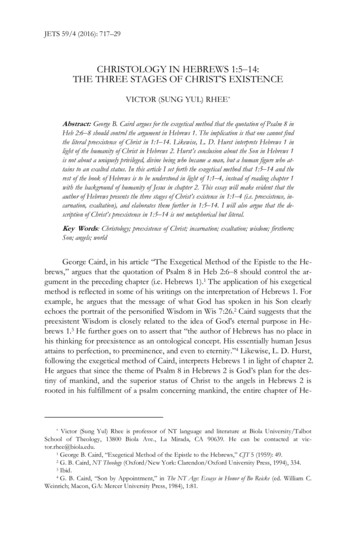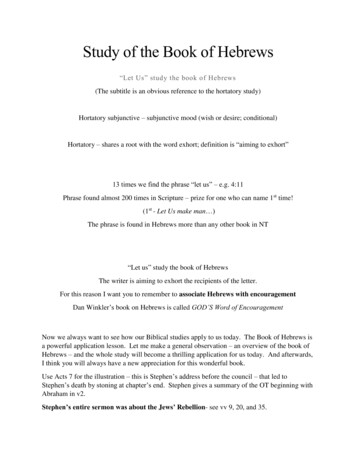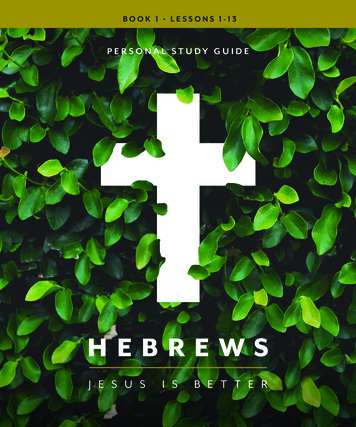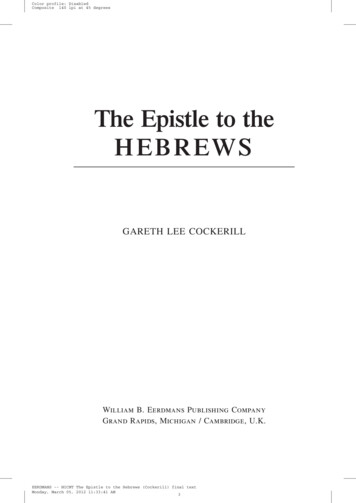
Transcription
Color profile: DisabledComposite 140 lpi at 45 degreesThe Epistle to theHEBREWSGARETH LEE COCKERILLWilliam B. Eerdmans Publishing CompanyGrand Rapids, Michigan / Cambridge, U.K.EERDMANS -- NICNT The Epistle to the Hebrews (Cockerill) final textMonday, March 05, 2012 11:33:41 AM3
Color profile: DisabledComposite 140 lpi at 45 degrees 2012 Gareth Lee CockerillAll rights reservedPublished 2012 byWm. B. Eerdmans Publishing Co.2140 Oak Industrial Drive N.E., Grand Rapids, Michigan 49505 /P.O. Box 163, Cambridge CB3 9PU U.K.Printed in the United States of America18 17 16 15 14 13 127 6 5 4 3 2 1Library of Congress Cataloging-in-Publication DatapagesCockerill, Gareth Lee.The Epistle to the Hebrews / Gareth Lee Cockerill.cm.— (The New international Commentary on the New Testament)Includes bibliographical references and indexes.ISBN 978-0-8028-2492-9 (cloth: alk. paper)1. Bible. N.T. Hebrews — Commentaries. I. Title.BS2775.3.C625 2012227 .8707 — dc232011052836www.eerdmans.comEERDMANS -- NICNT The Epistle to the Hebrews (Cockerill) final textMonday, March 05, 2012 11:33:41 AM4
Color profile: DisabledComposite 140 lpi at 45 degreesCONTENTSEditor’s PrefacexiiAuthor’s CTION1I. HEBREWS IN ITS ENVIRONMENTA. The Pastor Who Wrote Hebrews1. Authorship and Canonicity2. Candidates for Authorship — A ReviewB. The Pastor’s SermonC. The Pastor’s Congregation1. What the Sermon Reveals about Its Hearers2. Were These Hearers Jewish or Gentile in Background?D. The Pastor’s Worldview1. The Pastor’s Dependence on the Christian Tradition2. The Pastor and the Heavenly/Futuristic Eschatology ofApocalyptic Writings3. The Pastor and the Influence of Neo-PlatonismE. When Did the Pastor Write This Sermon?II. THE MESSAGE OF HEBREWSA. The Sermon’s Use of the Old TestamentviiEERDMANS -- NICNT The Epistle to the Hebrews (Cockerill) final textMonday, March 05, 2012 11:33:41 AM722361116161924242528344141
Color profile: DisabledComposite 140 lpi at 45 degreesContents1. Introduction2. Fundamental Assumptions3. The Psalms and Related Passages —“God Has Spoken”4. The Pentateuch — Moses Bears “Witness to theThings That Would Be Spoken”5. The Historical Books (Joshua through Nehemiah)6. Hebrews 3:4–4:11; 7:1-10; and 12:18-247. Continuity and Typology8. Hebrews and Contemporary Jewish Use of theOld Testament9. Contemporary RelevanceB. The Sermon’s Rhetorically Effective Structure1. Introduction2. Hebrews 1:1–2:18 and 12:4-19: God Has Spokenfrom the Mountain3. Hebrews 3:1–4:13 and 10:19–12:3: On Pilgrimageto the Promised Home4. Hebrews 1:1–4:13 and 10:19–12:29: The Disobedientand the Faithful5. Hebrews 13:1-25: The Peroration (and Letter Ending)6. Hebrews 4:14–10:18: Entering the Most Holy Place7. The Rhetorical Shape of Hebrews and Its Use of theOld Testament8. The Rhetorical Shape of Hebrews and Ancient RhetoricC. The Sermon’s Abiding MessageD. The Sermon’s OutlineTEXT, EXPOSITION, AND NOTESI. A VERY SHORT HISTORY OF THE DISOBEDIENTPEOPLE OF GOD (1:1–4:13)A. Sinai Revisited: God Has Spoken in the Eternal,Incarnate, Now Exalted Son (1:1–2:18)1. God Has Spoken through His Son (1:1-4)viiiEERDMANS -- NICNT The Epistle to the Hebrews (Cockerill) final textMonday, March 05, 2012 11:33:41 6
Color profile: DisabledComposite 140 lpi at 45 degreesContents2. The Incomparable Majesty of the Eternal, ExaltedSon (1:5-14)3. The Urgency of Attending to God’s Son-MediatedRevelation (2:1-4)4. The Crucial Importance of the Incarnate, SufferingSon (2:5-18)B. Tested at Kadesh-Barnea: Avoid the Congregationof the Disobedient (3:1–4:13)1. Consider Jesus, A Son over the House of God (3:1-6)2. Avoid the Company of the Faithless Generation(3:7-19)3. Pursue the Blessing Lost by the Faithless Generation(4:1-11)4. You Are Accountable before the Word of God(4:12-13)II. THE SON’S HIGH PRIESTHOOD — RESOURCE ANDURGENCY FOR PERSEVERANCE (4:14–10:18)A. The Life of Faith and the High Priesthood of theSon (4:14–5:10)1. Embrace This Great High Priest (4:14-16)2. The New High Priest and the Old (5:1-10)B. Don’t Be Unresponsive but Grasp What ChristHas Provided (5:11–6:20)1. Reverse Your Unnatural Regression (5:11–6:3)2. Avoid the Danger of Apostasy (6:4-8)3. Shun Apostasy and Embrace the Community ofthe Faithful (6:9-12)4. Trust God’s Promise Verified by God’s Oath (6:13-20)C. Our High Priest’s Legitimacy and Eternity (7:1-28)1. Melchizedek Is Greater than Levi (7:1-10)2. The Priest in “the Likeness of Melchizedek”Displaces Aaron (7:11-25)3. This Priest Is Exactly the Kind of Priest We Need(7:26-28)D. Our High Priest’s All-Sufficient Sacrifice:A Symphony in Three Movements (8:1–10:18)ixEERDMANS -- NICNT The Epistle to the Hebrews (Cockerill) final textMonday, March 05, 2012 11:33:41 9284293295313337345
Color profile: DisabledComposite 140 lpi at 45 degreesContents1. First Movement: The New Promised (8:1-13)a. A Minister of the Sanctuary and True Tent (8:1-2)b. A Different Sacrifice (8:3-6)c. A Better Covenant (8:7-13)2. Second Movement: The Old Antiquated; the NewForeshadowed (9:1-22)a. Limitations of the Earthly Sanctuary (9:1-10)b. The All-Sufficiency of Christ’s Sacrifice (9:11-15)c. Freed from the Condemnation of a BrokenCovenant (9:16-22)3. Third Movement: The New Explained (9:23–10:18)a. Sanctuary: “In the Presence of God for Us”(9:23-24)b. Sacrifice — “Once for All” (9:25–10:4)c. Sacrifice — “To Do Your Will, O God” (10:5-10)d. Sacrifice — “He Sat Down Forever” (10:11-14)e. Covenant — “Where There Is Release” (10:15-18)III. A HISTORY OF THE FAITHFUL PEOPLE OF GOD FROMCREATION TO CONSUMMATION (10:19–12:29)A. The Life of Persevering Faith and the HighPriesthood of the Son (10:19-39)1. Avail Yourselves of This Great Priest (10:19-25)2. You Are More Accountable Because of This HighPriest (10:26-31)3. Pursue the Blessing Promised the Faithful (10:32-39)B. The Past History of the People of God until theComing of Jesus (11:1–12:3)1. Join the Company of the Faithful of Old (11:1-40)a. From Creation to Noah: The Foundations ofFaith (11:1-7)b. Abraham, Faith at Its Best: Perseverance in anAlien World (11:8-22)c. Moses, Faith under Stress: A Story of Resistanceand Triumph (11:23-31)d. The Rest of the Story — A “Better Resurrection”(11:32-38)xEERDMANS -- NICNT The Epistle to the Hebrews (Cockerill) final textMonday, March 05, 2012 11:33:42 60464481495514516519535564585
Color profile: DisabledComposite 140 lpi at 45 degreesContentse. “They without Us . . .” (11:39-40)2. Keep Your Eyes on Jesus, Seated at God’s RightHand (12:1-3)C. The Present History of the People of God until theConsummation (12:4-29)1. God’s True Sons and Daughters Endure the Disciplineof Suffering (12:4-13)2. Don’t Sell Your Birthright, as Esau Did (12:14-17)3. God’s Firstborn Enter His Presence through theExalted Jesus (12:18-24)4. God Will Speak “Once More” at the Final Judgment(12:25-29)IV. INSTRUCTIONS FOR THE LIFE OF GRATITUDE ANDGODLY FEAR (13:1-25)A. The Community of the Faithful and the Life ofGratitude and Godly Fear (13:1-6)B. The Unbelieving World and the Life of Gratitudeand Godly Fear (13:7-17)C. A Sermon Sent as a Letter (13:18-25)INDEXESSubjectsNamesScripture and Other Ancient TextsxiEERDMANS -- NICNT The Epistle to the Hebrews (Cockerill) final textMonday, March 05, 2012 11:33:42 AM11596600613614631642660673677688710723730735
Color profile: DisabledComposite 140 lpi at 45 degreesEDITOR’S PREFACEIt is with considerable mixed emotions that I (gladly) introduce this commentary to the reading public. On the one hand, this work represents a signal endof an era for this commentary series, since it is both replacing a commentaryby the second general editor (F. F. Bruce) and is the final editorial task of thethird general editor, whose onsetting bout with Alzheimer’s disease has necessitated his relinquishing this task, even though a few additional replacement volumes are still in the mill, as it were. I have had the privilege of working with Gary Cockerill quite closely over the past several years, and ampleased heartily to commend this commentary to the primary intended readership of this series — the proverbial “busy pastor” and biblical students incolleges and seminaries. The reader will quickly recognize that the author isnot only well acquainted with the secondary literature on this great biblicalbook, but has also brought his own deep love for the author of Hebrews andhis work to the task so that it shines throughout these pages. I am glad to beable to commend it to one and all.Gordon D. FeexiiEERDMANS -- NICNT The Epistle to the Hebrews (Cockerill) final textMonday, March 05, 2012 11:33:42 AM12
Color profile: DisabledComposite 140 lpi at 45 degreesAUTHOR’S PREFACEHebrews is a literary work from the first-century Hellenistic world. Yet theexposition that follows in this commentary does not treat this book at a distance as if it were a laboratory specimen. My intention is to do more than explicate an ancient document within its context and then draw some analogiesfor contemporary believers. I would enable modern readers to enter theChristian world of Hebrews and allow that world to reshape their hearts andminds. I hope this commentary will help those who approach this ancient butever-relevant text to hear the word God has spoken in his Son, enter the divine presence through the cleansing he provides, and persevere through obedient faithfulness in fellowship with the people of God. Richard Hays has reminded the church that the purpose of biblical exposition is to enter thebiblical narrative and allow it to transform the hearer’s perspective and behavior.1 There is no better book for carrying out this mandate than the Letterto the Hebrews.In our initial conversations concerning this book Professor GordonFee asked me to justify issuing a new volume on Hebrews in this series. Isuggested that developments over the past decades in the study of ancientrhetoric, in the analysis of Hebrews’ structure (particularly through discourseanalysis), and in intertextual studies warranted such a venture. I am gratefulthat he agreed. No NT book is more diligent in presenting the OT Scripturefor its Christian hearers than this book, which begins by declaring: “God,who spoke in the prophets, . . . has now spoken in One who is Son.” None of1. Richard B. Hays, First Corinthians, Interpretation (Louisville: John Knox,1997), 173: “One of our fundamental pastoral tasks is to teach our congregations to findthemselves in the stories of Israel and the early church. . . . Our pedagogy has failed miserably to teach this skill because we have usually tried too hard to make the text ‘relevant.’Rather than seeking to make the text relevant, Paul seeks to draw his readers into the textin such a way that its world reshapes the norms and decisions of the community in thepresent. That is the task of biblical preaching.”xiiiEERDMANS -- NICNT The Epistle to the Hebrews (Cockerill) final textMonday, March 05, 2012 11:33:42 AM13
Color profile: DisabledComposite 140 lpi at 45 degreesAuthor’s Prefacefers a higher degree of rhetorical sophistication. One does not have to embrace all of the methodology advocated by various practitioners of these disciplines to be enriched by their work.First of all, then, this commentary is based on a fresh analysis of thestructure and rhetorical shape of Hebrews. Each individual passage is interpreted with sensitivity to the role it plays within the author’s overall strategyfor persuading his hearers to embrace the truth he presents and to act accordingly. I believe you will benefit significantly from engaging the full presentation of this structural analysis in the Introduction before proceeding to the exposition of your favorite passage. The opening paragraphs of each sectionand subsection of the exposition also situate the particular portion of the textunder consideration in relation to the whole. It may seem audacious to present yet another structural analysis of Hebrews. I offer this analysis humbly,only after carefully listening to the text of Hebrews, and with deep appreciation for all that I have gained from other analyses. I ask you, the reader, tojudge this analysis on the basis of its ability to enrich your understanding ofindividual passages and of Hebrews as a whole.This commentary also offers fresh insight into Hebrews’ use of theOT. The author of Hebrews understands the relationship between God’s wordin the Son and previous revelation as one of continuity and fulfillment. Hisapproach has much that can enrich contemporary Christian biblical interpretation. My understanding of this subject as given in the Introduction to thiscommentary informs the exposition of the commentary proper.When people discovered that I was writing a commentary on Hebrewsthey would almost invariably ask, “Well, who wrote it?” One certainly canand must study Hebrews within its first-century environment. In my judgment, however, the evidence available is insufficient to determine with certainty the name of the author or to be overly precise about the location, specific identity, and situation of the recipients. Thus those who base theirinterpretation on an unduly specific reconstruction of Hebrews’ origin arelikely to skew their understanding of the book in proportion to the idiosyncrasy of their proposal. Nevertheless, each proposal highlights some aspectof Hebrews. Thus we will survey various proposals in the Introduction not somuch to determine which one is correct as to benefit from the insight eachprovides.It is necessary to say something about translation, textual variants,and secondary sources. I have done my own translation of Hebrews so that Iwould not be under obligation to critique a particular version and so that Icould make stylistic features and various emphases of the Greek text morereadily accessible to the English reader. Many commentaries on Hebrewsprovide extensive analysis of textual variants. I have addressed textual issuesonly when they significantly impact interpretation and as part of the exposixivEERDMANS -- NICNT The Epistle to the Hebrews (Cockerill) final textMonday, March 05, 2012 11:33:42 AM14
Color profile: DisabledComposite 140 lpi at 45 degreesAuthor’s Prefacetion itself rather than in a separate section. Due to the increased volume ofscholarly publication, one can no longer claim to have mastered all of the literature on Hebrews. I have tried to be as comprehensive as possible and to interact with the sources that seemed most helpful. I am glad that the fine commentary by Peter O’Brien appeared just in time for consideration. I regretthat my friend David Allen’s commentary came just a bit too late.I owe a great debt of gratitude to many for their help and encouragement. First of all, I am indebted to Professor Fee for giving me this opportunity and especially for his clear feedback on my initial draft of the openingchapters. That feedback set the direction for the whole. I would be amiss toomit my appreciation for my doctoral mentor, Professor Mathias Rissi, although this is not the commentary on Hebrews that he would have written.He first sparked my academic interest in Hebrews and guided my study withboth insight and encouragement. My thanks to Ron Smith and Ray Easley,former President and Dean, respectively, of Wesley Biblical Seminary, for arranging my schedule and providing other resources that facilitated this project. Dan Burnett, Director of Library Services for Wesley Biblical Seminary,has graciously responded to my many requests for interlibrary loans. I am especially grateful to Kenneth Elliott, Director of the Library at ReformedTheological Seminary, Jackson, Mississippi, and to John McCarty, the Circulation Director. They cheerfully provided me with bibliographical resources,with a research room that greatly facilitated the completion of this project,and with collegial camaraderie. Milt Essenburg, of Eerdmans Publishing, hasgiven me the encouragement in these final months that he has given to somany other commentators before me.I am profoundly grateful to my friend since graduate school days,Dave Steveline, without whose encouragement this book would never havebeen begun. I wish to thank my daughter Allene and two sons-in-law, CareyVinzant and David O’Donnell. Carey not only read the manuscript of thiscommentary with the eye of both a stylist and a theologian but also preparedthe indexes. Allene and David provided extensive help with the Bibliography. I am grateful to my three daughters, Allene, Ginny, and Kathy, for theirencouragement over the years, and, most of all to my wife of more than fortyyears, Rosa, who has patiently, graciously, and lovingly lived these past yearsfor the time “after commentary.” It is to her, to our children by birth and bymarriage, to our grandchildren, and to Dave that I would dedicate this volume.Gareth Lee CockerillxvEERDMANS -- NICNT The Epistle to the Hebrews (Cockerill) final textMonday, March 05, 2012 11:33:42 AM15
Color profile: DisabledComposite 140 lpi at 45 degreesABBREVIATIONSI. BIBLICAL TEXTS AND TNRSVREBRSVT/NIVTEVTNIVUBS4Contemporary English VersionEnglish Standard VersionHolman Christian Standard BibleKing James VersionSeptuagint (Old Greek Old Testament)Masoretic Text (Standard Hebrew Old Testament)Novum Testamentum Graece. Nestle-Aland, 27th ed.New American BibleNew American Standard BibleNew Jerusalem BibleNew King James VersionNew Living TranslationNew Revised Standard VersionRevised English BibleRevised Standard VersionToday’s New International Version/New InternationalVersionToday’s English VersionToday’s New International VersionThe Greek New Testament. United Bible Societies, 4th ed.II. JOURNALSAUSSBBRAndrews University Seminary StudiesBulletin for Biblical ResearchxviEERDMANS -- NICNT The Epistle to the Hebrews (Cockerill) final textMonday, March 05, 2012 11:33:42 AM16
Color profile: DisabledComposite 140 lpi at 45 evQSBLSPSJTSPhiloTJTynBulTZWTJZNWBiblicaBiblical ResearchBibliotheca sacraThe Bible TranslatorBiblische ZeitschriftCatholic Biblical QuarterlyCalvin Theological JournalCurrents in Research: Biblical StudiesEvangelical QuarterlyExpository TimesGrace Theological JournalHarvard Theological ReviewInterpretationJournal of Biblical LiteratureJournal of the Evangelical Theological SocietyJournal for the Study of the New TestamentJournal of Theological StudiesNovum TestamentumLa nouvelle revue théologiqueNew Testament StudiesRevue bibliqueReview and ExpositorRevue de QumranSociety of Biblical Literature Seminar PapersScottish Journal of TheologyStudia philonicaTrinity JournalTyndale BulletinTheologische ZeitschriftWestminster Theological JournalZeitschrift für die neutestamentliche Wissenschaft und dieKunde der älteren KircheIII. REFERENCE WORKSBDAGBDFW. Bauer, F. W. Danker, W. F. Arndt, and F. W. Gingrich,Greek-English Lexicon of the New Testament and OtherEarly Christian Literature. 3rd ed. Chicago, 1999F. Blass, A. Debrunner, and R. W. Funk, A GreekGrammar of the New TestamentxviiEERDMANS -- NICNT The Epistle to the Hebrews (Cockerill) final textMonday, March 05, 2012 11:33:42 AM17
Color profile: DisabledComposite 140 lpi at 45 TTDNTDictionary of the Later New Testament and ItsDevelopment. Edited by R. P. Martin and P. H. Davids.Downers Grove: InterVarsity Press, 1997Greek-English Lexicon of the New Testament: Based onSemantic Domains. Edited by J. P. Louw and E. A. Nida.2nd ed. New York, 1989H. G. Liddell, R. Scott, H. S. Jones, and R. McKenzie, AGreek-English LexiconA Grammar of New Testament Greek, by J. H. Moulton(vol. 1), W. E. Howard (vol. 2), and N. Turner (vols. 3-4)J. H. Moulton and G. Milligan, The Vocabulary of theGreek New TestamentJ. H. Charlesworth, ed., Old Testament PseudepigraphaPatrologia graeca ( Patrologiae cursus completus: Seriesgraeca). Edited by J.-P. Migne. 162 vols. Paris, 1844-64H. Strack and P. Billerbeck, Kommentar zum NeuenTestamentB. M. Metzger, A Textual Commentary on the Greek NewTestamentTheological Dictionary of the New Testament. Edited byG. Kittel and G. Friedrich. Translated by G. W. Bromiley.10 vols. Grand Rapids: Eerdmans, 1964-76IV. SERIESABACCS: NTAnBibANTCBUBZNWCBQMSHNTJSNTSupKEKLCLAnchor BibleAncient Christian Commentary on Scripture: NewTestamentAnalecta biblicaAugsburg New Testament CommentaryBiblische UntersuchungenBeihefte zur Zeitschrift für die neutestamentlicheWissenschaftCatholic Biblical Quarterly Monograph SeriesHandbuch zum Neuen TestamentJournal for the Study of the New Testament: SupplementSeriesKritisch-exegetischer Kommentar über das Neue Testament(Meyer-Kommentar)Loeb Classic LibraryxviiiEERDMANS -- NICNT The Epistle to the Hebrews (Cockerill) final textMonday, March 05, 2012 11:33:42 AM18
Color profile: DisabledComposite 140 lpi at 45 SSNTSMSTNTCWBCWUNTLibrary of New Testament StudiesMoffatt New Testament CommentaryMarburger Theological StudiesNew Century Bible CommentaryNew International Biblical Commentary: New TestamentRegensburger Neues TestamentSources bibliquesSociety of Biblical Literature Dissertation SeriesSociety for New Testament Studies Monograph SeriesTyndale New Testament CommentaryWord Biblical CommentaryWissenschaftliche Untersuchungen zum Neuen TestamentV. APOSTOLIC FATHERSBarn.1-2 Clem.Did.Herm. Mand.Herm. Sim.Herm. Vis.Ign. Eph.Ign. Magn.Ign. Phld.Ign. Trall.Mart. Pol.Pol. Phil.Barnabas1-2 ClementDidacheShepherd of Hermas, MandateShepherd of Hermas, SimilitudeShepherd of Hermas, VisionIgnatius, To the EphesiansIgnatius, To the MagnesiansIgnatius, To the PhiladelphiansIgnatius, To the TralliansMartyrdom of PolycarpPolycarp, To the PhilippiansVI. CLASSICAL SOURCESAnn.Claud.Cyr.Diatr.Enn.Ep.Eth. Nic.Hist.Tacitus, AnnalesSuetonius, Divus ClaudiusXenophon, CyropaediaEpictetus, Diatribai (Dissertationes)Plotinus, EnneadesSeneca, Epistulae moralesAristotle, Nichomachean Ethics/Ethica nichomacheaHerodotus, Histories/HistoriaexixEERDMANS -- NICNT The Epistle to the Hebrews (Cockerill) final textMonday, March 05, 2012 11:33:42 AM19
Color profile: DisabledComposite 140 lpi at 45 .Rhet.Quintilian, Institutio oratoriaCicero, De inventione rhetoricaXenophon, MemorabiliaPlutarch, MoraliaCicero, De officiisArtemidorus, OnirocriticaPollux, OnomasticonAristotle, Rhetoric/RhetoricaVII. CHURCH FATHERS1 Apol.Civ.Dial.Epist.Haer.Hist. eccl.Hom. Heb.Mart.Pan.Peregr.Pud.Vir. ill.Justin Martyr, 1 Apology/Apologia IAugustine, The City of God/De civitate DeiJustin Martyr, Dialogue with Trypho/Dialogus cumTryphoneJerome, EpistulaeHippolytus, Refutation of All Heresies/Refutatio omniumhaeresiumEusebius, Ecclesiastical History/Historia ecclesiasticaChrysostom, Homiliae in epistulam ad HebraeosTertullian, To the Martyrs/Ad martyrasEpiphanius, Refutation of All Heresies/Panarion (AdversusHaereses)Lucian, The Passing of Peregrinus/De morte PeregriniTertullian, Modesty/De pudicitiaJerome, Lives of Illustrious Men/De viris illustribusVIII. JOSEPHUSAg. Ap.Ant.J.W.LifeAgainst Apion/Contra ApionemJewish Antiquities/Antiquitates judaicaeJewish War/Bellum judaicumThe Life/VitaxxEERDMANS -- NICNT The Epistle to the Hebrews (Cockerill) final textMonday, March 05, 2012 11:33:42 AM20
Color profile: DisabledComposite 140 lpi at 45 degreesAbbreviationsIX. APOCRYPHA AND PSEUDEPIGRAPHABar1-2 Esd1-4 MaccJdtSirSusTobWisApos. Con.As. Mos.Ascen. Isa.1 En.2 En.3 En.2 Bar.3 Bar.4 EzraJos. Asen.Jub.L.A.B.L.A.E.Let. Aris.Liv. Pro.Mart. Isa.Mart. Pet. PaulPss. Sol.Sib. OrT. Benj.T. DanT. Iss.T. Jos.T. Jud.T. LeviT. Mos.T. Reu.T. Sim.Baruch1-2 Esdras1-4 sdom of SolomonApostolic Constitutions and CanonsAssumption of MosesMartyrdom and Ascension of Isaiah 6–111 Enoch (Ethiopic Apocalypse)2 Enoch (Slavonic Apocalypse)3 Enoch (Hebrew Apocalypse)2 Baruch (Syriac Apocalypse)3 Baruch (Greek Apocalypse)4 EzraJoseph and AsenethJubileesLiber antiquitatium biblicarum (Pseudo-Philo)Life of Adam and EveLetter of AristeasLives of the ProphetsMartyrdom and Ascension of Isaiah 1–5Martyrdom of Peter and PaulPsalms of SolomonSibylline OraclesTestament of BenjaminTestament of DanTestament of IssacharTestament of JosephTestament of JudahTestament of LeviTestament of MosesTestament of ReubenTestament of SimeonxxiEERDMANS -- NICNT The Epistle to the Hebrews (Cockerill) final textMonday, March 05, 2012 11:33:42 AM21
Color profile: DisabledComposite 140 lpi at 45 degreesAbbreviationsX. PHILOAbrahamAgricultureAlleg. nkennessEmbassyEternityFlaccusFlightGiantsGood tyPrelim. StudiesQEQGRewardsSacrificesSobrietySpec. LawsUnchangeableVirtuesWorseOn the Life of Abraham/De AbrahamoOn Agriculture/De agriculturaAllegorical Interpretations/Legum allegoriaeOn the Cherubim/De cherubimOn the Confusion of Tongues/De confusione linguarumOn the Creation of the World/De opificio mundiOn the Decalogue/De decalogoOn Dreams/De somniisOn Drunkenness/De ebrietateOn the Embassy to Gaius/Legatio ad GaiumOn the Eternity of the World/De aeternitate mundiAgainst Flaccus/In FlaccumOn Flight and Finding/De fuga et inventioneOn Giants/De gigantibusThat Every Good Person Is Free/Quod omnis probusliber sitWho Is the Heir?/Quis rerum divinarum heres sitOn the Life of Joseph/De IosephoOn the Migration of Abraham/De migratione AbrahamiOn the Life of Moses/De vita MosisOn the Change of Names/De mutatione nominumOn Planting/De plantationeOn the Posterity of Cain/De posteritate CainiOn the Preliminary Studies/De congressu eruditionisgratiaQuestions and Answers on Exodus/Questiones etsolutiones in ExodumQuestions and Answers on Genesis/Questiones etsolutiones in GenesinOn Rewards and Punishments/De praemiis et poenisOn the Sacrifices of Cain and Abel/De sacrificiis Abeliset CainiOn Sobriety/De sobrietateOn the Special Laws/De specialibus legibusThat God Is Unchangeable/Quod Deus sit immutabilisOn the Virtues/De virtutibusThat the Worse Attacks the Better/Quod deterius potioriinsidari soleatxxiiEERDMANS -- NICNT The Epistle to the Hebrews (Cockerill) final textMonday, March 05, 2012 11:33:42 AM22
Color profile: DisabledComposite 140 lpi at 45 degreesAbbreviationsXI. DEAD SEA SCROLLSGen. is Apocryphon (1QapGenar)Thanksgiving HymnsWar ScrollPesher HabakkukRule of the CommunityRule of the Congregation (Appendix a to 1QS)Rule of the Blessings (Appendix b to 1QS)4Q Visions of Amramb (4Q533)4QBlessingsf (4Q280)Midrash on Eschatologya (Catena)4QDeuteronomy32 (4Q44)Midrash on Eschatologyb (4QFlorilegium)Songs of the Sabbath Sacrificea-b 4Q400-4Q4014QTestimonia11QMelchizedek (11Q13)Cairo Genizah copy of the Damascus DocumentXII. RABBINIC LITERATURE (TARGUMS)Frg. Tg.Gen. Rab.Tg. Neof.Tg. Onq.Tg. Ps.-J.Fragmentary TargumGenesis RabbahTargum NeofitiTargum OnqelosTargum Pseudo-JonathanxxiiiEERDMANS -- NICNT The Epistle to the Hebrews (Cockerill) final textMonday, March 05, 2012 11:33:42 AM23
Color profile: DisabledComposite 140 lpi at 45 degreesBIBLIOGRAPHYI. COMMENTARIESThese commentaries are cited by last name, volume number where appropriate, and page.Andriessen, Paul, and A. Lenglet. De Brief aan de Hebreeën. Roermond, Netherlands: Roman and Zonen, 1971.Attridge, Harold W. The Epistle to the Hebrews. Hermeneia. Philadelphia: Fortress, 1989.Bénétreau, Samuel. L’Épitre aux Hebreux. 2 vols. Commentaire Évangélique dela Bible. Vaux-sur-seine: Édifac, 1989-90.Bleek, Friedrich. Der Brief an die Hebräer erläutert durch Einleitung,Übersetzung und fortlaufenden Commentar. 2 parts in 3 vols. Berlin:Ferdinand Dümmler, 1936-40.Braun, Herbert. An die Hebräer. HNT 14. Tübingen: Mohr, 1984.Bruce, F. F. The Epistle to the Hebrews. Rev. ed. The New International Commentary on the New Testament. Grand Rapids: Eerdmans, 1990.Buchanan, George Wesley. To the Hebrews. AB 36. New York: Doubleday, 1972.Calvin, John. The Epistle of Paul the Apostle to the Hebrews and the First andSecond Epistles of St. Peter. Edited by David W. Torrance and Thomas F.Torrance. Translated by William B. Johnston. Calvin’s Commentaries 12.Grand Rapids: Eerdmans, 1963.Cockerill, Gareth L. Hebrews: A Bible Commentary in the Wesleyan Tradition.Indianapolis: Wesleyan Publishing House, 1999.Delitzsch, Franz. Commentary on the Epistle to the Hebrews. 2 vols. Translatedby Thomas L. Kingsbury. Edinburgh: T&T Clark, 1878.deSilva, David. Perseverance in Gratitude: A Socio-Rhetorical Commentary onthe Epistle “to the Hebrews.” Grand Rapids: Eerdmans, 2000.xxivEERDMANS -- NICNT The Epistle to the Hebrews (Cockerill) final textMonday, March 05, 2012 11:33:43 AM24
Color profile: DisabledComposite 140 lpi at 45 degreesBibliographyDods, Marcus. “The Epistle to the Hebrews.” In The Expositor’s Greek Testament, Vol. 4. W. Robertson Nicoll. New York: Dodd, Mead, 1910.Ellingworth, Paul. The Epistle to the Hebrews: A Commentary on the Greek Text.New International Greek Testament Commentary. Grand Rapids: Eerdmans, 1993.Fudge, Edward William. Hebrews: Ancient Encouragement for Believers Today.Abilene, TX: Leafwood, 2009.Gooding, David. An Unshakeable Kingdom: The Letter to the Hebrews for Today. Grand Rapids: Eerdmans, 1989.Gordon, R. P. Hebrews. 2nd ed., previously published by Sheffield AcademicPress, 2000. Readings: A New Biblical Commentary. Sheffield: SheffieldPhoenix Press, 2008.Grässer, Erich. An die Hebräer. 3 vols. Evangelisch-Katholischer Kommentar.Neukirchen: Benziger, 1990, 1993, 1997.Guthrie, Donald G. The Letter
4. Hebrews 1:1–4:13 and 10:19–12:29: The Disobedient and the Faithful 67 5. Hebrews 13:1-25: The Peroration (and Letter Ending) 70 6. Hebrews 4:14–10:18: Entering the Most Holy Place 70 7. The Rhetorical Shape of Hebrews and Its Use of the Old Testament 72 8. The Rhetorical Shape of Heb
